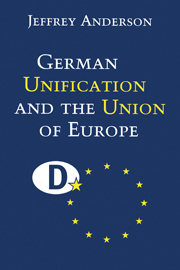Book contents
- Frontmatter
- Contents
- List of figures and tables
- Acknowledgments
- List of abbreviations
- 1 A new Germany in Europe?
- 2 Unification and “Germany in Europe”
- 3 Continuity in trade and internal market
- 4 Mixed outcomes in energy and environment
- 5 Change in competition policy
- 6 Change in structural funds and the CAP
- 7 A new Germany in Europe
- Bibliography
- Index
3 - Continuity in trade and internal market
Published online by Cambridge University Press: 22 September 2009
- Frontmatter
- Contents
- List of figures and tables
- Acknowledgments
- List of abbreviations
- 1 A new Germany in Europe?
- 2 Unification and “Germany in Europe”
- 3 Continuity in trade and internal market
- 4 Mixed outcomes in energy and environment
- 5 Change in competition policy
- 6 Change in structural funds and the CAP
- 7 A new Germany in Europe
- Bibliography
- Index
Summary
In the aftermath of unification, Germany's trade and internal market policies continued on much as before, despite the fact that domestic debates in these issue areas were vigorous, and in some instances, specifically relating to trade, challenged core government assumptions. The analytical task here is to explain the absence of policy change.
Trade policy
West Germany's postwar trade policy was Western-oriented and liberal. The strategy of export-led growth presumed an expanding, barrier-free European market, which enabled German firms to achieve scale economies and successfully penetrate foreign markets. The EC also helped the German economy by creating a zone of monetary stability and contributing to open international trade. Within this basic trade orientation, a complex mixture of security interests and domestic politics drove West Germany's foreign economic policy toward the Soviet Union and its Eastern bloc satellites. Ostpolitik, launched by the Brandt-Scheel government in 1970, sought to establish a sturdy regional détente capable of withstanding the vicissitudes of superpower relations, and to promote the cause of unification by drawing East Germany into ever-deepening ties (Wandel durch Annäherung).
Trade and the unification settlement, 1989–90
External trade proved to be one of the few truly contentious issues to occupy West German and Community negotiators during talks over the terms of the GDR's accession. The issue revolved around the question of Vertrauensschutz – in other words, meeting the “legitimate expectations” of the German Democratic Republic's trading partners, which were concentrated for the most part in the Soviet Union and Eastern Europe.
- Type
- Chapter
- Information
- German Unification and the Union of EuropeThe Domestic Politics of Integration Policy, pp. 56 - 82Publisher: Cambridge University PressPrint publication year: 1999



